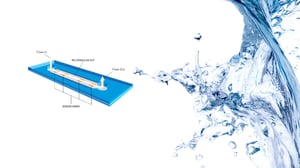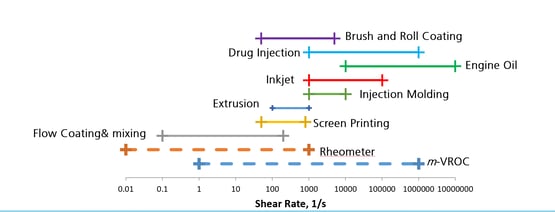Shear rate is defined as the flow velocity gradient in the direction perpendicular to the flow direction (ScienceDirect) and is a key parameter when measuring viscosity of both Newtonian and non-Newtonian fluids. Knowing and understanding shear rates enable you to explore various factors on how your sample behaves and can determine the fate of your product performance (RheoSense).
All RheoSense rectangular slit method viscometers (USP chapter 914) are powered by our patented VROC® (Viscometer-Rheometer-on-a-Chip) technology, combining microfluidic and MEMS (Micro-Electro-Mechanical Systems) technologies to measure dynamic viscosity over a wide dynamic range of operation. VROC viscometers control the flow rate of your sample and measures pressure to calculate shear rate and stress. While all RheoSense viscometers are powered by the same VROC technology, they all serve very different purposes and have unique specifications and applications. Each VROC powered viscometers is supported by its own software, helping to automate measurements, simplify protocols creation, and to organize and analyze your data.
The specifications and testing capabilities of each VROC powered viscometer are distinguished even further by the different chips you can use for each instrument! Our different chips allow:
- Testing different shear rates and viscosities using just one instrument
- Having multiple chips on hand will allow you to test a wider spectrum
- Reduce downtime when cleaning chips between samples (especially for our customers who have multiple RheoSense viscometers!)
When it comes to measuring your samples, the channel depth of the instrument you use will determine your shear rate range. The different VROC chips that pair with each instrument have different pressure ranges they can withstand and allow users to measure a range different flow channels. There are 4 different chip types for the m-VROC and VROC initium viscometers (A, B, C, E).
- A chips are ideal for low viscosity measurements with a viscosity range of 0.2 – 100 mPa-s and a maximum shear rate of 56,000 1/s. These chips are ideal for measuring proteins/ mAbs and low viscosity samples, such as lower concentration proteins, chemicals, water-based inks.
- A05 (50 µm), A10 (100 µm), A20 (200 µm), A30 (300 µm)
- B chips are idea for medium viscosity measurements with viscosity range of 0.2 – 3,000 mPa-s and a maximum shear rate of 100,000 1/s. These chips are ideal for measuring higher viscosity proteins, chemicals, water-based inks, and organic light-emitting diode (OLED).
- B05 (50 µm), B10 (100 µm), B20 (200 µm), B30 (300 µm)
- C chips are idea for high viscosity measurements with viscosity range of 10 – 14,000 mPa-s and a maximum shear rate of 200,000 1/s. These chips are ideal for measuring chemicals, inks, batteries, OLED, and cosmetics such as lotions and serums.
- C05 (50 µm), C10 (100 µm), C20 (200 µm), C30 (300 µm)
- E chips are idea for high shear measurements with viscosity range of 1 – 100,000 mPa-s and a maximum shear rate of 1,400,000 1/s. These chips are ideal for measuring high shear protein viscosity, glycerol, cannabis oils, vape fluid, and gels.
- E05 (50 µm), E10 (100 µm), E20 (200 µm)
There are 3 different chip types for the microVISC (A, B, C). These chips share the same viscosity ranges as the m-VROC and initium chips, however they all have a maximum shear rate of 5,800 1/s due to the shear rate measurements capabilities of the microVISC instrument.
VROC chips need viscosity and shear rate in balance. The A05 chip is ideal for low viscosity fluids and intrinsic viscosity measurements whereas the E02 chip is ideal for high viscosity & high shear rates.

Learn more about selecting the right chip for your VROC instrument and samples
*Shear rate max could potentially vary depending on sample
If you want to learn more about selecting the right instrument or chip for your samples, contact us to speak with one of our rheology experts today!
Written by: Eden Reid, RheoSense Senior Marketing Associate





